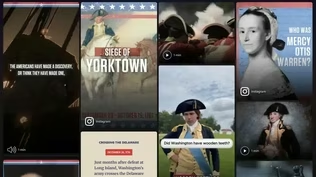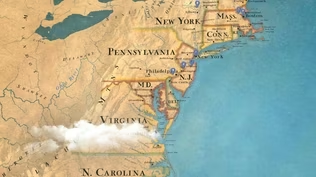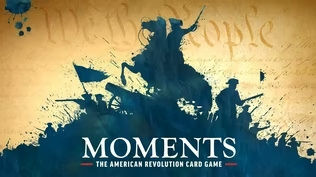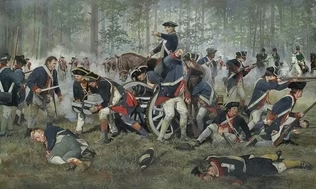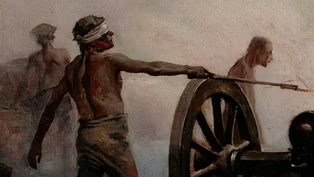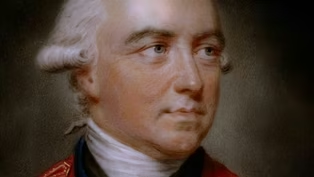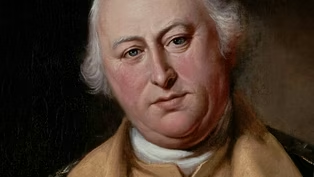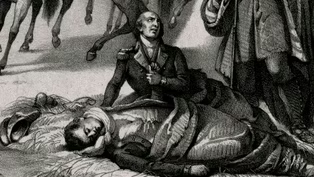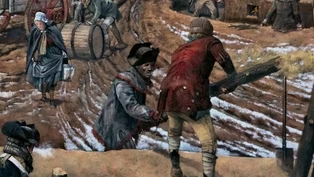
Financing the American Revolution
Clip: Episode 5 | 2m 59sVideo has Closed Captions
The economic realities of the war start to settle in for both the Americans and the British.
Securing resources for the American Revolution was top of mind for both sides. In the United States, funding the war effort meant borrowing money. This created an entire class of lenders with an interest in establishing a strong government to ensure they’d get repaid. The British had the funds, but how long should they pour money into a war with no end in sight?
Problems playing video? | Closed Captioning Feedback
Problems playing video? | Closed Captioning Feedback
Episodes presented in 4K UHD on supported devices. Corporate funding for THE AMERICAN REVOLUTION was provided by Bank of America. Major funding was provided by The Better Angels Society and...

Financing the American Revolution
Clip: Episode 5 | 2m 59sVideo has Closed Captions
Securing resources for the American Revolution was top of mind for both sides. In the United States, funding the war effort meant borrowing money. This created an entire class of lenders with an interest in establishing a strong government to ensure they’d get repaid. The British had the funds, but how long should they pour money into a war with no end in sight?
Problems playing video? | Closed Captioning Feedback
How to Watch The American Revolution
The American Revolution is available to stream on pbs.org and the free PBS App, available on iPhone, Apple TV, Android TV, Android smartphones, Amazon Fire TV, Amazon Fire Tablet, Roku, Samsung Smart TV, and Vizio.

MOMENTS: The Revolutionary War Card Game
Use your knowledge of Revolutionary-era moments to build a timeline of real historical events.Providing Support for PBS.org
Learn Moreabout PBS online sponsorship[Bird squawks] Voice: You ask me, "Can the enemy continue to prosecute the war?"
I answer, "Can we carry on the war much longer?"
Certainly, no.
The true point of light, then, in which to place and consider this matter is not simply whether Great Britain can carry on the war, but whose finances-- theirs or ours-- is most likely to fail.
[George Washington] Narrator: General Washington spent the first 5 weeks of 1779 in Philadelphia, summoned there by Congress.
It was not a happy visit.
"I never was much...afraid of the enemy's arms," Washington wrote a friend, but he did fear that people were wearying of the war that had gone on for 4 years and still had no end in sight, and Congress seemed mired, he said, in "party disputes and personal quarrels."
The value of Continental currency was melting "like snow before a hot sun," he complained, so that "a wagon load of money will scarcely purchase a wagon load of provisions."
Christopher Brown: On both the North American side and on the British side, there is an exhaustion that is settling in and an economic reality for both-- the American side, the question of coming up with the resources every year to be able to fight the war-- uniforms, guns, paying the men, replacing the ones who die, replacing the ones who desert.
Britain has the money, but it starts to look a little bit like a sunk-cost problem.
"Are we going to continue to pour money into an effort when there's no end in view?"
♪ Hogeland: One of the critical ways by which the Revolutionary War was funded was debt.
There were a number of ways to raise money, but the best ways were to borrow, so you had to go to lenders, largely a merchant class, but also planters and even some prosperous farmers.
It was a bit of a risky speculation because getting paid back and getting your interest paid would depend upon winning this extremely unlikely war.
Nonetheless, that was a pretty good way of raising money to fight the Revolution, and it created an entire class of American lenders with strong interests in creating a very strong government because that was the only way they could see themselves getting paid their interest.
♪ Voice: Shall we at last become the victims of our own abominable lust of gain?
Forbid it, heaven.
Forbid it all.
Our cause is noble.
It is the cause of mankind, and the danger to it springs from ourselves.
George Washington.
Video has Closed Captions
Clip: Ep5 | 8m 56s | The Continental Army engages the British in the last major battle in the North of the Revolution. (8m 56s)
Britain and the Southern Strategy
Video has Closed Captions
Clip: Ep5 | 4m | When it becomes clear that the British won’t win in New England, they set their sights on the South. (4m)
The British Siege of Charleston
Video has Closed Captions
Clip: Ep5 | 4m 44s | The British surround and siege Charleston, South Carolina, one of the largest cities in America. (4m 44s)
Video has Closed Captions
Clip: Ep5 | 5m 56s | The American Revolution has spilled into a global war, but the United States hangs on by a thread. (5m 56s)
Preview: The Soul of All America
Video has Closed Captions
Preview: Ep5 | 30s | The war drags on and moves to new theaters: at sea, in Indian Country, and in the South. (30s)
Spain Joins the American Revolution Against the British
Video has Closed Captions
Clip: Ep5 | 5m 43s | Spain joins the war, but not as an ally of American independence – as an enemy of Britain. (5m 43s)
Winter at Valley Forge: Hardship & Desperation
Video has Closed Captions
Clip: Ep5 | 4m 26s | The Continental Army threatens to unravel while suffering harsh winter conditions at Valley Forge. (4m 26s)
Providing Support for PBS.org
Learn Moreabout PBS online sponsorshipSupport for PBS provided by:
Episodes presented in 4K UHD on supported devices. Corporate funding for THE AMERICAN REVOLUTION was provided by Bank of America. Major funding was provided by The Better Angels Society and...

